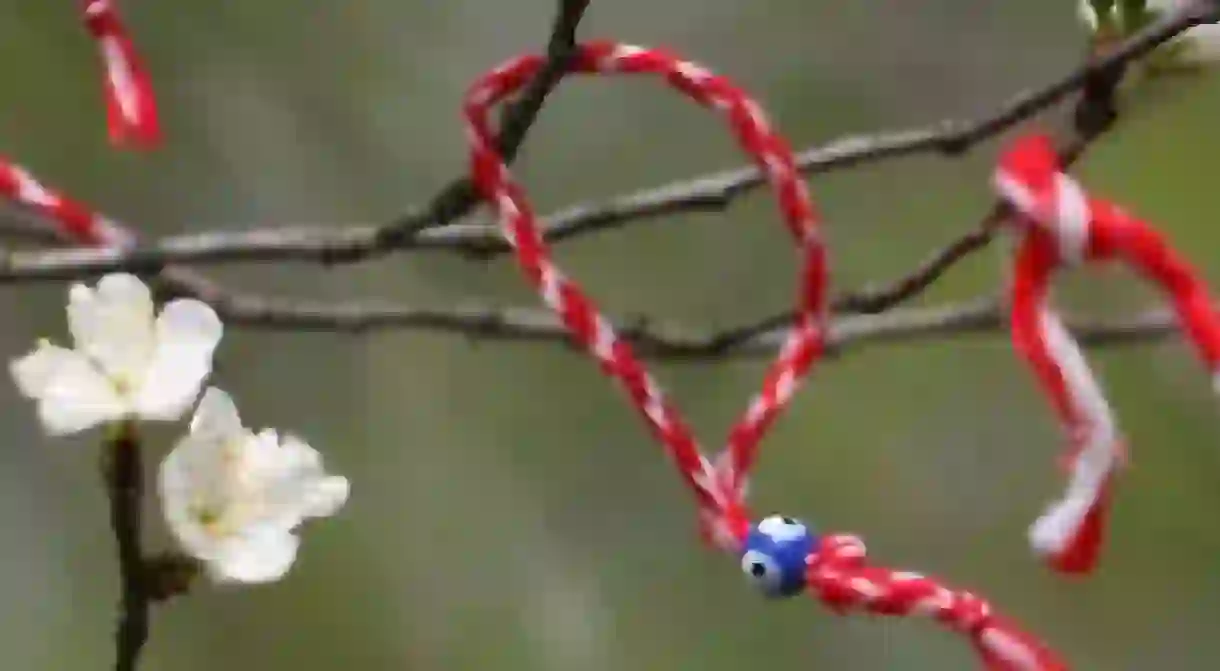Martia: The Balkan Tradition Of Spring

March is synonymous with the coming of spring. It is therefore often associated in many world cultures with social practices, rituals, and festive events that represent rebirth and new life. For centuries the peoples of the Balkan peninsula have welcomed the first day of spring by wearing the Martia, a traditional charm made of red and white thread, worn for protection and good luck.

Most ancient cultures of south-eastern Europe used to welcome the new year on the first day of spring, at the same time as the beginning of the new agrarian year. In ancient Rome, New Year’s Eve was originally celebrated on the first of March, a month named in honor of the god, Mars. Before he was popularized as the mighty god of war, Mars was actually a fertility and agricultural deity. Along with other deities like Ceres, he insured nature’s rebirth and encouraged the continuation of life.
And so, symbolically, March came to embody revitalization and a new beginning. Most associate March with its unpredictable weather patterns. This particular feature of the month stimulated folk imagination, and several myths, legends, and traditions are associated with March’s sudden and tempestuous weather changes. This folklore places a strong emphasis on luck and protection against the inherent perils of this transitional period of the year. In Greece, one such legend tells the story of an old woman who defied the month’s unpredictable weather. In retaliation, March borrowed a day from February, which then had fewer days, and froze the old woman to her death.

Martia is a centuries-old tradition that is practiced by most peoples of the Balkan peninsula, although specific features of the ritual may vary across regions and countries. According to Greek sources, the custom is believed to originate from antiquity, and more specifically the Eleusinian mysteries. During initiation ceremonies, participants would wear a red thread around their right wrist and left ankle. Young women would use the adornments to decorate Athena’s sculptures and then wash them in a nearby river and hide them for a year, until they were passed on to the next generation.
In present-day Greece, Martia is offered to children on the first day of March, who usually wear it around their wrists or ankles. According to common belief, the thread protects the children from the strong rays of the spring sun. The adornment is made of two twisted strings of textile, usually wool, cotton, or silk, one red and one white. Upon seeing the first swallow that symbolizes the coming of spring, Martia is removed and placed on rose bushes, only to be taken by the birds that will use it to build their nest. In some areas, Martia is wrapped around the big toe of its owner, thus protecting him from missteps.

Unchanged, this cultural practice can be found in Macedonia, called Martinka, as well as in Albania, known as Verore. On the first day of March, people tie around their wrist a red and white bracelet in anticipation of the first sign of the spring. The bracelet symbolizes the coming of spring, and brings health and luck to its owner and the community. In some places, the talisman is tied on a tree to wish for a fruitful and prosperous season. A similar old custom, anchored in pagan practices and agricultural cults of nature, survived in Bulgaria. Bulgarians greet the first day of March, a holiday known as Baba Marta, wearing a collar decoration made of entwined red and white threads, the famous Martenitsa. Most commonly, Martenitsa comes in the form of two small dolls, Pizho and Penda, a white male and red female textile figure. White is associated with strength and purity, while red symbolizes health and fertility.
The adornments are exchanged as a sign of affection and appreciation between friends or family, and are usually pinned on cloths or carried around the neck. In Bulgarian folklore, Martenitsa is also a powerful amulet protecting its owner from ill fortune and disease. In some regions, residents put up Martenitsa decorations outside their houses to exorcise Grandma Marta or Baba Marta, a grumpy old woman with extreme mood swings, who is the personification of the month of March.

In Romanian and Moldavian tradition, women would fashion a small object of two twisted threads of wool, one red and one white. This Mărţişor is offered to loved ones on the first day of March. The red string symbolizes beauty and the white purity, closely related to the beautiful snowdrop flower that blooms in March. People would put them around their neck, wrist, or ankle, or pin them on their clothes, close to their heart.
In some cases, a Mărţişor would be placed at the house or the stable entrance or around the neck of livestock to protect the household and its owners during the new agrarian year. After the arrival of the first swallow, the artifact would be left on a tree or bush, or be hidden under a stone.

Over the years, the tradition of Martia has greatly inspired traditional craftsmanship and folklore art. At present, the once simple trinket has evolved to incorporate small pieces of jewelry and wooden, leather, and ceramic tokens, as well as a variety of symbols believed to bring good luck and prosperity.
On the initiative of several countries where this fascinating tradition lives on, the custom of Martia and all relevant cultural practices associated to the first of March, were proposed for inclusion in UNESCO’s List of the lntangible Cultural Heritage. Martia is currently under consideration for inclusion in 2015’s representative list.













